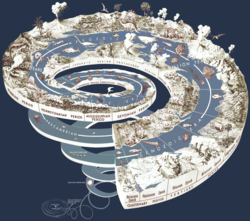Chronologie de l'évolution du vivant
l'évolution
Échelle : millions d'années.
Orange : glaciation
Voir aussi : la frise chronologique de l'Univers et Histoire de la Terre
Orange : glaciation
Voir aussi : la frise chronologique de l'Univers et Histoire de la Terre
Cet article présente une chronologie de l'évolution du vivant.

- −4,54 milliards d'années : formation de la Terre
- −4,52 milliards d'années : formation de la Lune
- −4,4 milliards d'années : formation de l'hydrosphère[a] et de la croûte terrestre[1]
- −4,1 milliards d'années : grand bombardement tardif
- −4 milliards d'années : apparition de la tectonique des plaques
- −3,8 milliards d'années : apparition des premières cellules alors que la température de surface est comprise entre 40 et 80 °C [2],[3]
- −3,7 à −3,45 milliards d'années (absence de consensus scientifique) : apparition des premiers stromatolithes et de la photosynthèse anoxygénique[4],[5],[6]
- −3,2 milliards d'années : apparition des premiers acritarches
- −2,45 milliards d'années : apparition de la photosynthèse oxygénique
- −2,4 milliards d'années : Grande Oxydation et début de la glaciation huronienne
- −2,2 milliards d'années : transition procaryote-eucaryote (apparition des Grypania)
- −2,1 milliards d'années : apparition des premiers organismes multicellulaires (Gabonionta)[7]
- −1,8 milliard d'années : début du milliard ennuyeux, entre 1,8 et 0,8 Ga, caractérisé par une relative stabilité de l'atmosphère et un ralentissement apparent de l'évolution de la vie.
- −1,5 milliard d'années : apparition de la sexualité[8]
- −1 milliard d'années : début de la Terre boule de neige
- −575 millions d'années : explosion de l'Édiacarien
- −555 millions d'années : apparition des triploblastiques[b]
- −542 millions d'années : extinction fini-édiacarienne (en), explosion cambrienne
- −500 millions d'années : apparition des chordés
- −480 millions d'années : apparition des plantes terrestres
- −475 millions d'années : extinction Ordovicien-Silurien
- −400 millions d'années : apparition des insectes, des graines et des sarcoptérygiens (poumons)
- −370 millions d'années : extinction du Dévonien
- −365 millions d'années : apparition des tétrapodes
- −360 millions d'années : début de la glaciation du Karoo et apparition des amphibiens
- −330 millions d'années : apparition des amniotes
- −312 millions d'années : apparition des synapsides et des sauropsides
- −252 millions d'années : extinction Permien-Trias
- −230 millions d'années : apparition des dinosaures
- −220 millions d'années : extinction "mineure" du Trias, apparition des mammifères
- −200 millions d'années : extinction Trias-Jurassique
- −160 millions d'années : apparition des euthériens
- −150 millions d'années : apparition des oiseaux
- −135 millions d'années : apparition des plantes à fleurs
- −66 millions d'années : extinction Crétacé-Paléogène
Notes
modifier- ↑ La température initiale des océans étant de 230 °C[réf. nécessaire].
- ↑ Voir notamment le genre fossile Dickinsonia.
Références
modifier- ↑ (en) S A Wilde,J W Valley, W H Peck,C M Graham, « Evidence from detrital zircons for the existence of continental crust and oceans on the Earth 4.4 Gyr ago », Nature, no 409, , p. 175–178 (DOI 10.1038/35051550)
- ↑ (en) Matthew S. Dodd, Dominic Papineau, Tor Grenne et John F. Slack, « Evidence for early life in Earth’s oldest hydrothermal vent precipitates », Nature, vol. 543, no 7643, , p. 60–64 (ISSN 1476-4687, DOI 10.1038/nature21377, lire en ligne, consulté le )
- ↑ (en) C. Bounama, S. Franck et W. Von Bloh, « The fate of Earth's ocean », Hydrology and Earth System Sciences, vol. 5, no 4, , p. 569-576 (lire en ligne [PDF]).
- ↑ (en) Allen P. Nutman, Vickie C. Bennett, Clark R. L. Friend, Martin J. Van Kranendonk et Allan R. Chivas, « Rapid emergence of life shown by discovery of 3,700-million-year-old microbial structures », Nature, vol. 537, no 7621, 22 septembre 2016 (publication en ligne : 31 août 2016), p. 535-538 (DOI 10.1038/nature19355, lire en ligne).
- ↑ David Larousserie, « Les plus anciennes traces de vie découvertes au Groenland », Le Monde.fr, (ISSN 1950-6244, lire en ligne, consulté le )
- ↑ (en) Abigail C. Allwood, Minik T. Rosing, David T. Flannery, Joel A. Hurowitz & Christopher M. Heirwegh, « Reassessing evidence of life in 3,700-million-year-old rocks of Greenland », Nature, (DOI 10.1038/s41586-018-0610-4).
- ↑ (en) El Albani et coll., « Large colonial organisms with coordinated growth in oxygenated environments 2.1 Gyr ago », Nature, no 466, , p. 100-104 (DOI 10.1038/nature09166)
- ↑ Gilles Bœuf, La biodiversité, de l’océan à la cité, Collège de France, , p. 7.
- Cet article est partiellement ou en totalité issu de l'article intitulé « Histoire évolutive du vivant » (voir la liste des auteurs).
